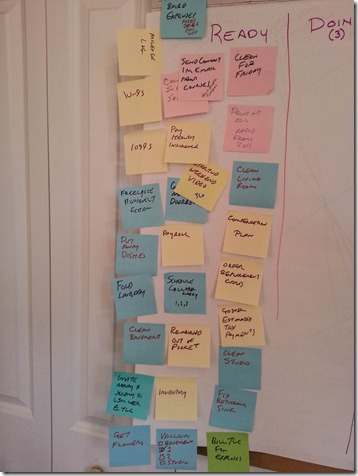Sharing some thoughts around my weekly homework from my neuroscience studies
Knowledge work is all about attention. Unfortunately that is a scarce resource, easily high jacked by any distraction. Multitasking, i.e. using focused attention on two different targets basically does not exist. What you are able to do is to do a lot of things on autopilot (i.e. walking, breathing, looking) while your executive network (incl. working memory) is doing something else (i.e. discussing). When you think you are multitasking you are actually attention switching, with a high cost in performance. For this you will allocate attention toward or away from interference, maintain relevant memory in mind, and reactivate representations if the maintenance of what you are doing is disrupted (Clapp et al, 2010). So when you are working with a need for cognitive logical thinking, minimizing any distractions is a great preventive method.Kanban is a method for managing knowledge work with an emphasis on just-in-time delivery while not overloading the team members. The core mechanisms in Kanban is to start where you are at, work in an evolutionary and incremental way to develop the system, limit the work in progress, and finish one thing before starting another. (Wikipedia, Kanban, 29.10.2014).While Kanban is used on a team/organizational level and longer time spans, the same logic applies on personal level and short time spans, too. From a neuroscience perspective, Kanban is too interesting to fit in a 300 words homework.
A couple of Kanban-insights from the neuroscience perspective
Limiting the number of similar things you work on will lessen the cost of attention switching and thus positively impact performance on the task at hand. (a no brainer) (Clapp et al, 2010).
Focused attention means you are using your long-term learning mechanisms (Medial temporal areas) to encode the experience. This makes the knowledge accessible by conscious thought later on (vs. using striatal habit learning, creating more unconscious and automatic learning). (Forde et al, 2006)
A “healthy” backlog is genius from a neuroscience perspective. Attending to an issue (backlog item) then leaving it with the knowledge of that you will return to it, seems to activate your unconscious processing. So while you are consciously focused on your work in progress (WIP), your unconscious works on items, which you know you will attend to later. (Backlog) (Ritter & Dijksterhuis, 2014)
Kanban definitely requires more in-depth analyzing from the neuroscience perspective. My hunch is that Kanban fits many of our biological & neuronal requirements, so I will definitely be dissecting Kanban some more in my studies.Where’s the scalpel?/Riina
References
Clapp, W.C, Rubens, M.T., Gazzaley A. ,(2010), Mechanisms of Working Memory Disruption by External Interference, Cerebral Cortex, April, 20:859-872
Foerde, K. , Knowlton, B. J., Poldrack, R.A.(2006), Modulation of competing memory systems by distraction. PNAS, August 1, 2006, vol. 103, 31, p 11778-11783.
Ritter, S.M., DIjksterhuis, A., (2014), Creativity – the unconscious foundations of the incubation period, Frontiers in Human Neuroscience, April, Vol 8:215, p.1-10.
Picture: Photo credit: o.tacke / Foter / CC BY












